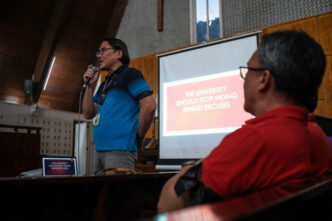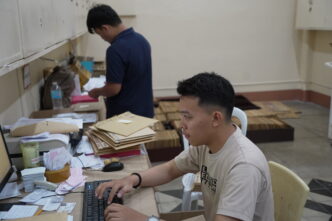By Kaela Aidelynne Orcullo and Reyan Gabriel Calumpang
Albeit known for its quality education, Silliman University (SU) continues to face the problem of inadequate facilities. From broken lights to inefficient lecture rooms, students claimed that these affect their learning environment.
According to the Philippine Accrediting Association of Schools, Colleges and Universities, colleges and departments in SU are qualified for its “overall excellence in the delivery of programs and services” with “no major deficiencies that compromise its educational effectiveness.”
However, this institutional achievement bears no weight when the prevailing issue contradicts the university’s goal towards effective facilities addressing the needs of the stakeholders.
With damaged amenities and worn-out infrastructures, students are seeking substantial response from the administration to re-evaluate their efficiency and provide more conducive and safe learning spaces.
Issues in Katipunan Hall
One building that carries these concerns is the Katipunan Hall—a century-old building formerly used as a mission hospital now houses various academic departments, such as the School of Public Affairs and Governance, Sociology and Anthropology department, and English department, among others. It is unsurprising that the building itself is worn down after being used for a long time.
Nonetheless, students voiced out that despite the importance of preserving the campus buildings and its heritage, it should not be an excuse to ignore the damages that impact both students and staff.
School of Public Affairs and Governance (SPAG) Society Governor Lynnette Layon reported an incident where ceiling lights fell and were precariously held by wires in one of the rooms.
“It is unfortunate how we still have to reach to that point where our facilities would really show that they are incapable of service before there is a maintenance check on our equipment,” she said.
Moreover, first-year foreign affairs major Fia Villavito shared that there are problems in the said building concerning both facility and utility.
“Katipunan Hall is very old. And I get that we are put here because [SPAG] is a relatively small college, but for me, it isn’t really a conducive learning space unlike other buildings,” she said.
Villavito also expressed her concerns for the stairs leading up to the college council room being “dangerous and hard to climb up to” and further highlighted internet problems, stating “The WiFi also does not reach here [the council room] and if it does it is very inconsistent.”
These issues, Villavito noted, discourage students from doing work at Katipunan Hall and forcing them to look for alternative spaces they can utilize.
Moreover, second-year foreign affairs major Athena Visitacion shared that most students and teachers “tolerate” the state of the rooms but have still claimed how it is “a bother and a distraction” for most.
Visitacion recalled how the air conditioning in one of their rooms caused a sound that would distract lectures. The typical resolve is turning it off to avoid further disturbance during class discussions. But this problem is seemingly just one of many.
Layon further noted the lack of maintenance for air conditioning units, pointing out that they remain dusty and have not yet received basic cleaning.
While their facilities often cause a disruption in their classroom, Visitacion also revealed that their college dean has already pursued efforts in aiding these concerns, such as requesting for a better air conditioner.
She said, “I believe [SPAG] Dean Ferdinand Mangibin has made efforts in requesting for better air conditioning but it is yet to be granted.”
Complaints at Ausejo Hall
College of Arts and Sciences Dean Dr. Mae Brigitt Bernadel L. Villordon said that the Ausejo Hall, though a relatively new building equipped with modern amenities, is also reported for having minor maintenance issues. These include malfunctioning door knobs, burnt-out lightbulbs, and occasional air conditioning problems.
Students have also expressed that the building’s dysfunctional elevator is pointless. For instance, pharmacy major Jiulianna Valbuena said that the elevator should also be fixed.
Valbuena remarked, “There are not that many problems aside from minor inconveniences but my number one complaint would be the broken elevator. What is it there for?”
“So those are the commons [concerns], the aircon, doorknobs, lights, and then [comfort rooms] […] If there are problems, because we have janitors there who can easily check and identify if there needs to be repaired,” Villordon stated.
Furthermore, Villordon detailed that the lack of sound insulation has occasionally caused disruptions during lectures in Ausejo Hall, as outside noise seeps into learning spaces.
“The only complaint that I received when it comes to the delivery is the very bad acoustics of AH. The sound proofing is not very good, so when the teacher discusses and the students [talk], it echoes. Even if the teacher also discusses, it [also] echoes. So actually that’s one of my topics or plans for next year.” Villordon added.
Addressing this issue has become part of the university’s future plans for improving classroom facilities, with steps being considered to enhance soundproofing measures in Ausejo Hall.
Concerns in Angelo King
On another side of the campus, Angelo King building is struggling with not only facilities but also space.
According to the Institute of Clinical Laboratory Sciences Dean (ICLS) Dr. Teodora A. Cubelo, the ICLS students are only using portions of the second floor while also sharing with the Institute of Rehabilitative Sciences (IRS) students.
“Instead of using the two rooms for ICLS, only one room is being utilized there. So if we talk about this particular building, this was created way back in 1995 [to] 1996. And so, as you can see, some of the windows are no longer closed because it utilized an old way of putting the casement windows.” Cubelo said.
The same concern is shared by second-year physical therapy student Ella Vasquez. She stated that with the student population “rapidly and inevitably increasing,” it is expected that there should be more classrooms or spaces conducive for learning.
According to Vasquez, “Hallways have become the students’ common area. And the library has made way to becoming another laboratory room. This should be an even greater concern for the department as it aims to expand its umbrella with the future offer of occupational therapy (OT).”
“This would require specific equipment to be purchased or installed to fully reach goals of education. For the meantime, Angelo King faculty and staff make do with what we have to make learning holistic,” she added.
Cubelo also reported that their office would keep on calling the people in charge of facilities and management due to different concerns they had to face.
“We never open the windows because the glass [panes] could just fall downstairs and somebody might be hit. The extension room that we created [used to be] an open balcony. With [occasional flooding], the water would just drip. I don’t know if it’s the roofing or the connection. I don’t really know how they could rehabilitate that.” Cubelo stated.
She further expressed her problems regarding the water and electricity outage due to strong winds which caused blackouts and the fuse to reverse.
“So our [emergency] eye showers [in] the laboratory do not even flush strong water so it’s just like a white elephant. So there should be something done with the [pressure] of the water in this building. Of course, I think it’s also experienced by other students [on] campus.”
IRS Governor Tobit Caballo also expressed the same concerns about the building’s electricity.
“The main concern has been the frequent brownouts that [have] affected the classes of the department.”
According to Caballo, the frequency of the brownouts has added to the concerns of IRS students on the management of the electricity distribution for the university despite having a generator.
FMAS’ response
Noisy air conditioning units, inconsistent electricity, and broken doors are among the piling up concerns regarding the university’s facilities.
The Facilities Management and Administrative Service (FMAS) office is tasked with the upkeep and repair of campus facilities, ensuring that university buildings and classrooms remain functional and well-maintained.
The university provides FMAS with an allocated budget specifically for maintenance, allowing the department to address issues as they arise.
“Anything that has something to do with major repairs, replacements, construction, it’s usually under the [Buildings and Grounds], or [now] the FMAS, facility management office, [and] the university [allots a budget] for that.” Villordon said.
In managing repairs, FMAS prioritizes facilities with the “highest level of dysfunction,” particularly those that affect classroom use. This approach ensures that maintenance efforts are directed toward spaces with the most critical needs.
“We work on the principle of prioritization. So who will be prioritized? What needs to be prioritized? Does it mean that this particular [program’s urgent concerns] will be replaced? Yes. But at the moment, for now, who needs to be prioritized?” Villordon shared.
FMAS Officer-in-Charge Engr. Lorena Mariño said that in her assessment, most classroom facilities are in working condition with only some needing repairs or are waiting for renovations. She also added that faculty facilities are in “livable conditions.”
Mariño also revealed that there are facilities and buildings in need of more consideration.
“Generally buildings that are made of wood and are a few decades old need more attention and repairs than those made of cement. Areas that haven’t been noticed by end users that were infested with termites as well would be those that fall in this category,” she noted.
Mariño reported that the Ethel Chapman, Science Complex, and Katipunan Hall are all currently awaiting administrative decisions regarding their maintenance and facility improvement.
With regard to maintenance repairs and its urgency, Mariño emphasized that it would depend on the “magnitude” of the repair.
“If the issue will become a security concern [e.g. doors, etc.] then it would be prioritized. Similarly, if a plug has any issues and smells, immediate action will be done,” she said.
Mariño further stated that a Preventive Maintenance Program (PMP) has recently been implemented when asked about inspection schedules to fix maintenance issues.
“Currently, building administrators are doing their rounds on their assigned area and since Preventive Maintenance has been implemented less than a year [ago], I would have to say yearly,” Mariño replied.
She added, “Requisitions from end users or departments and reports from janitors on the other hand come in daily.”
The PMP is a program where different areas in the university will be checked on a quarterly, bi-annual, or annual period, depending on the item involved.
Future plans
Villordon has called on the university administration to address sound issues in Ausejo Hall classrooms by installing soundproofing materials.
“I included that in the budget, I think [for] next year and the following, but it will run for three years. I have requested the university to [install sound proofing material at] AH to improve the sound acoustics,” Villordon stated.
With regard to the Angelo King building, Dr. Cubelo voiced out that she cannot answer when the new building for ICLS will be completed.
“I can’t answer that. But in terms of plans, it’s ready, even the budget. We designed the building starting in 2022. It’s been three years now. That’s why we’re done with all the floors formed,” she said.
Cubelo remains hopeful in the realization of their new building, citing that the only thing the department is waiting for is the conduct of the bidding process and the construction itself.
Subsequently, Mariño affirmed that there are plans to improve the maintenance and overall condition of the university’s facilities.
However, she said that it is still a “slow gradual step-by-step process” since the full maintenance of a university that has a few dozen hectares and around 200 buildings will cost quite a “hefty sum.”
When asked about what the university can do to improve the efficiency of maintenance services, Mariño replied that SU needs a cooperative endeavor with students and faculty.
“We need the help of the end users to notify us when the damage is still small or when the damage was first spotted and, on our end, we will continue to improve our services to repair damages when it is still minimal,” she expressed.
Students also shared their expectations and outlined actions they hope the administration will take. They emphasized the necessity for urgent action, especially with safety concerns and academic needs on the line.
“Steps like regular maintenance and inspections should remain a priority of the school administration,” physical therapy student Lianro Bulado said.
According to Bulado, “A feedback system can also be a major step for the administration to consistently meet the needs of the students and the faculty.”
While future plans have been discussed by the administration, the timeline for implementation remains uncertain.
Currently, students have been actively voicing their concerns for improved facilities to ensure a more conducive learning environment and greater safety for everyone on campus.
As Silliman University continues to uphold its reputation for academic excellence, the current state of its facilities reveals a critical need for improved maintenance practices.
Addressing these issues is essential to fulfill the university’s goal of providing an effective and safe educational environment for all its students because, despite the university’s commitment to providing an optimal educational setting, these issues have notably undermined the overall student experience.
This is a developing story.












